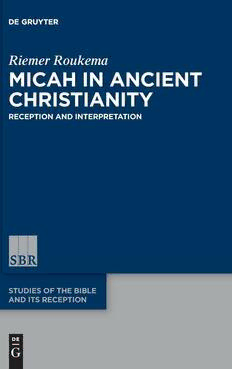
Micah in Ancient Christianity: Reception and Interpretation PDF
Preview Micah in Ancient Christianity: Reception and Interpretation
Riemer Roukema Micah in Ancient Christianity Studies of the Bible and Its Reception Edited by Christine Helmer, Steven McKenzie, Thomas Römer, Jens Schröter, Barry Dov Walfish, and Eric Ziolkowski Volume 15 Riemer Roukema Micah in Ancient Christianity Reception and Interpretation ISBN 978-3-11-066340-2 e-ISBN (PDF) 978-3-11-066602-1 e-ISBN (EPUB) 978-3-11-066391-4 ISSN 2195-450X Library of Congress Control Number: 2019944384 Bibliographic information published by the Deutsche Nationalbibliothek The Deutsche Nationalbibliothek lists this publication in the Deutsche Nationalbibliografie; detailed bibliographic data are available in the Internet at http://dnb.dnb.de. © 2019 Walter de Gruyter GmbH, Berlin/Boston Logo: Martin Zech Printing: CPI books GmbH, Leck www.degruyter.com To the memory of Tjitze Baarda (1932–2017) Preface TheoriginofthisbookliesinStrasbourg,whereIworkedasprofessorinthehis- toryofancientChristianityandpatristicstudiesattheFacultyofProtestantThe- ologyof the – then so called – Université Marc Bloch from 2000 to 2002. Iwas invitedtoparticipateinateamthatwastocomposethevolumeonMicahinthe seriesLaBibled’Alexandrie,whichconsistsofFrenchtranslationsoftheSeptua- gint,includingextensiveannotationsandintroductions.Mytaskwouldbetore- searchthepatristicinterpretationofMicah,sothatitsresultscouldbeincluded bothintheannotationstothetranslationandintheintroduction.Iacceptedthe invitation,andasateamwecontinuedtoworkontheprojectafterIreturnedto theNetherlands,where–forthetimebeing–Ifinalizedmyresearch.However, forreasonsthatarenotrelevanthere,thecompletionofthevolumeMichéeofLa Bible d’Alexandrie was delayed.When it was clear to me that for the coming yearsitspublicationcouldnotbeexpected,IdecidedtorewritemyFrenchdocu- ment in English, to add detailed references to the ancient sources – footnotes thatwerenotrequiredintheFrenchseries–andtoexpanditwithothermateri- al.Thishasresultedinthisbook,whosescopeconsiderablyexceedsmyoriginal French introduction and notes. For my research I have benefited from the help of several colleagues. My thanks go to Jan Joosten for drawing my attention to the book of Micah and for sharing his insights into its version in the Septuagint; to Mats Eriksson for sending a copy of his PhD thesis on Hesychius of Jerusalem’s Scholia on the Twelve Prophets; to Adelrich Staub osb for lending a copy of his PhD thesis on Jerome’s Commentary on the Twelve Prophets; to Thomas Scheck for sending the translation of Jerome’s Commentary on Micah before it was published; to Hans van Loon for elucidating some passages of Cyril of Alexandria; to Frans van Liere for a scan of Rahmer’s book on Jerome’s use of Jewish sources and for his reference to Andrieu’s Ordines Romani; to Lucas Van Rompay for his in- formation on Syriac literature and some recent publications; to Gerard Rouw- horst for his comments on my earlier paper on the Improperia; to Stefan Royé for clarifying my questions about the Byzantine Typika; to Barry Hartog for his remarksonJesus’allegedquotationfromMic1:7inJewishsources;tothelibrar- ians of the Protestant Theological University in Amsterdam and Groningen for supplying many books and articles from our own and other libraries; to the li- brarians of the Theological University in Kampen (‘Broederweg’),the University ofGroningen,andVUUniversityinAmsterdam;toJacobFaberforimprovingthe Englishstyleofsomeoftheshorterchapters;toAnthonyRuniawhohaschecked and corrected my English in the whole book (though I am responsible for re- https://doi.org/10.1515/9783110666021-001 VIII Preface mainingerrors);to Jesse de Bruin for his assistance in compiling the bibliogra- phy;andtoLilyBurggraaffwhohasalwaysshownherinterestintheprogressof this work. Contents Abbreviations XIII I Introduction 1 II Micah in the New Testament 5 II. Bethlehem, the birthplace of the Christ (Mic 5:1 [5:2]) 5 II. The families divided (Mic 7:6) 7 II. Conclusion 9 III Church Fathers: Introduction 10 III. Ancient Christian authors on the Twelve Prophets 10 III. The need for interpretations of the Twelve Prophets 13 III. Criteria for the selection of patristic interpretations 17 III. Translations of the ancient Commentaries on the Twelve Prophets 20 IV Heterodox views 22 IV. Introduction 22 IV. Heterodox references to Micah 24 IV.. Irenaeus on the Ophites’ view of Micah 24 IV.. Micheus and Michar in Sethian works 25 IV.. Heterodox interpretations of Micah 31 IV... Evil coming down from the Lord (Mic 1:12b) 31 IV... Spears and swords transformed (Mic 4:3c [Isa 2:4c]) 32 IV... Should Christians abstain from procreation? (Mic 6:7cd) 33 IV.. Heterodox reminiscences (Mic 7:6) 35 IV. Conclusion 35 V Patristic interpretation of Micah 37 V. Micah’s name and identity (Mic 1:1a) 38 V. The historical context of Micah’s prophecies (Mic 1:1bc) 42 V. Hear the words, all peoples (Mic 1:2) 43 V. The Lord descending on the mountains and valleys (Mic 1:3–5) 45 V. Samaria’s destruction because of its idolatry (Mic 1:6–7) 51 V. Samaria’s captivity and Jerusalem’s siege (Mic 1:8–9) 55 V. Gath and Akim addressed (Mic 1:10–11) 58 X Contents V. Jerusalem threatened by the Assyrians (Mic 1:12–13a) 63 V. Lachis and Odollam (Mic 1:13b–15b) 65 V. The eagle’s widowhood or baldness (Mic 1:15c–16) 67 V. The fields divided up (Mic 2:1–5a) 70 V. No tears! (Mic 2:5b–8) 73 V. Everlasting mountains (Mic 2:9–11a) 78 V. Spirit, lie, and captivity (Mic 2:11b–12) 81 V. The capture of Jerusalem (Mic 2:13) 88 V. Israel’s unrighteous leaders (Mic 3:1–4) 90 V. The false prophets (Mic 3:5–8) 93 V. Jerusalem ploughed like a field (Mic 3:9–12) 99 V. The nations will go up to the mountain of the Lord (Mic 4:1–3 // Isa 2:2–4) 102 V. The Lord will reign on Mount Zion (Mic 4:4–7) 114 V. The kingdom from Babylon (Mic 4:8–10) 117 V. A clash between Zion and the nations (Mic 4:11–14 [4:11–5:1]) 124 V. The future ruler from Bethlehem (Mic 5:1–2 [5:2–3]) 128 V. The Lord will shepherd his flock (Mic 5:3–4c [5:4–5c]) 136 V. The fate of Assyria and the land of Nimrod (Mic 5:4d–5 [5:5d– 6]) 141 V. Israel’s remnant unassailable among the nations (Mic 5:6–8 [5:7–9]) 146 V. Destruction and vengeance (Mic 5:9–14 [5:10–15]) 153 V. The Lord’s lawsuit against Israel (Mic 6:1–2) 157 V. The Lord’s interrogation and retrospective (Mic 6:3–5) 160 V. What should we do? (Mic 6:6–7) 166 V. Thisis what the Lord requires (Mic 6:8) 169 V. The voice of the Lord (Mic 6:9ab) 174 V. Injusticeand punishment (Mic 6:9c–16) 175 V. Micah’s lament (Mic 7:1–3d) 182 V. Like a moth on a rod (Mic 7:3e–4) 186 V. Distorted relationships (Mic 7:5–6) 191 V. Israel’s salvation and its enemy’s devastation (Mic 7:7–13) 194 V. Israel’s peace and vindication (Mic 7:14–17) 202 V. God’s compassion and forgiveness (Mic 7:18–20) 211 V. Conclusions 216 V.. Diverging punctuation and delimitation 216 V.. Syntactical difficulties 217
